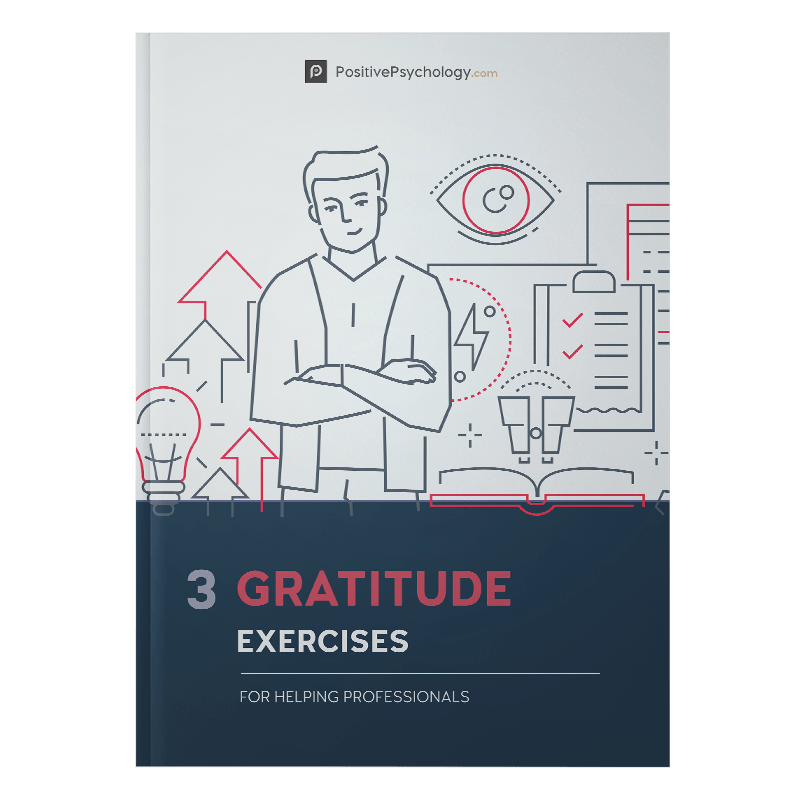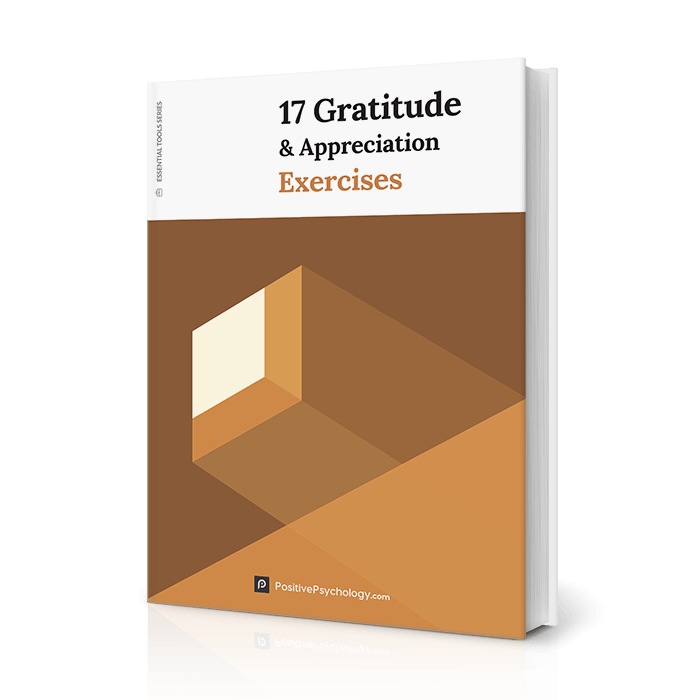 The act of gratitude plays an important role in psychological wellbeing and self-actualization (Maslow, 1981).
The act of gratitude plays an important role in psychological wellbeing and self-actualization (Maslow, 1981).
Regular expression of gratitude leads to increased feelings of happiness (Dickens, 2017), as well as reports of higher life satisfaction, meaningfulness, and productivity (Emmons & Crumpler, 2000).
In this post, we will explore gratitude and ways to introduce the act of expressing gratitude into everyday life. Gratitude refers to the emotion of feeling grateful, or a “felt sense of wonder, thankfulness, and appreciation for life” (Emmons & Shelton, 2002, p. 360), and it is a worthwhile topic to explore.
In life, the object of our gratitude can vary (Emmons & Shelton, 2002):
- It might be directed toward other people, like our friends or family.
- We might feel gratitude toward living and nonliving objects.
- We might be grateful for experiences, opportunities, and important and unimportant events.
Knowing that gratitude has so many benefits, how can we foster a habit of expressing gratitude? We’ll present you with several different tools, such as journal prompts, worksheets, and one-minute journal techniques to help you do just that.
Before you continue, we thought you might like to download our three Gratitude Exercises for free. These detailed, science-based exercises will help you or your clients connect to more positive emotions and enjoy the benefits of gratitude.
This Article Contains:
12 Gratitude Journal Prompts and Templates
A regular expression of gratitude results in numerous positive outcomes (Emmons & McCullough, 2003). In the first experimental study to investigate whether the act of expressing gratitude resulted in higher reports of psychological wellbeing, participants were randomly assigned to one of three groups:
- A group who journaled about things that they were grateful for
- A group who journaled about things that annoyed them
- A group who journaled about recent events that ‘affected’ them
Each group journaled for 10 weeks. After 10 weeks, the participants in the gratitude group reported that they were more optimistic about their life, reported more incidents of physical exercise, and expressed fewer symptoms of illness than the participants in the other two groups.
In subsequent experiments, the authors replicated the finding that regular gratitude journaling resulted in more optimism and a general sense of happiness with one’s life, led to more acts of kindness, more reported hours of sleep, and feeling more refreshed in the morning.
How to start a gratitude journal
Your first step toward starting a gratitude journal is to purchase a notebook for journaling. Any notebook that suits you will do. The point is to have a book dedicated to journaling.
On the first page, write out these instructions for journaling, which we have adapted from instructions given to the gratitude-journaling group in Emmons and McCullough (2003):
There are many things that we can be grateful for. Some of these things can be big, but some can also be very small. These things also differ from one person to the next. Think about the past week, and list five things in your life that you are grateful for.
Remember that the items you are grateful for do not have to be limited to only people in your life, and what you might be thankful for is unique to you.
Perhaps you’re grateful for reading a specific book, listening to a song or your favorite band, legs that can carry you, or even something abstract like your faith or learning to practice patience.
If you find the prompt used by Emmons and McCullough (2003) too vague, then consider using the following directed prompts:
- In the last week, what did you do that you are grateful for?
- In the last week, what did someone else do that you are grateful for?
- In the last week, what did you learn you are grateful for?
- In the last week, what did you feel that you are grateful for?
- In the last week, what did someone else say to you that you are grateful for?
- In the last week, is there a feeling that you felt that you are grateful for?
- In the last week, is there a sensation (that you saw/heard/smelled/tasted/felt) that you are grateful for?
Using the prompts given by Emmons and McCullough (2003), here is an example of things that I am grateful for:
- I am grateful to feel the sun on my face and to hear the birds in my garden.
- I am grateful that I get along with husband’s family and enjoy their company.
- I appreciate the opportunities that I have to produce work.
- I appreciate it that my colleague asked me for my advice and my opinion on a piece of work. This made me feel like I was good at my job.
- I appreciate the gratitude book that I am reading and the time that I have before bed to read.
Additionally, you must practice gratitude journaling continuously. Although people who express gratitude report higher levels of life satisfaction and lower levels of depression than people who do not engage in gratitude journaling, these differences disappear three months after the journaling has ended (O’Connell, O’Shea, & Gallagher, 2017).
Therefore, aim to practice gratitude journaling regularly for maximum continued benefits.
The benefits of adding a behavioral component to your gratitude journal
A further step, after you have started journaling, is to include a behavioral component to your gratitude journaling.
Most gratitude journaling is focused internally and only has a reflection component; for example, your journal entries are a personal, private expression of gratitude, but the expressions of gratitude toward people in your life are never openly expressed to them.
When asked to combine their gratitude journaling with a behavioral component, such as expressing their gratitude to the person they are grateful for, then participants reported even higher on measures of positive emotions and lower on measures of negative emotions than participants who only wrote down (i.e., reflected) on things that they were grateful for (O’Connell, et al., 2017).
Similar positive effects were found by Lambert, Clark, Durtschi, Fincham, and Graham (2010). Participants were randomly assigned to one of four groups:
- Expressed their gratitude to their partner/friend
- Focused on the daily activities
- Thought about how appreciative they were of their partner/friend
- Recalled a positive memory, which they then discussed with their partner/friend
Lambert et al. (2010) found that compared to the other three groups, participants who expressed their gratitude to the partner/friend reported higher ‘communal strength,’ a concept that refers to the sense of responsibility that one has toward another person’s wellbeing, which could be a measure of relationship investment.
Therefore, regularly expressing gratitude toward your partner/friend might increase your perceived sense of your investment in your relationship and may result in other benefits such as further expression of supportive acts from your partner.
Steps to include a behavioral component
To incorporate a behavioral component into your gratitude journaling, we have modified the instructions used by O’Connell et al. (2017). At the end of each week, after journaling, choose one person who you feel grateful toward and express your gratitude to them. To do this, follow the following four steps:
- Choose one person to express your gratitude to.
- Write them a gratitude message on a note, through social media, or in an email.
- Express your appreciation for a specific action that they performed.
- After expressing your gratitude, reflect on their reaction to your message and how that made you feel.
Our 8 Favorite Printable PDFs

If you need more prompting with starting a gratitude journal, you might try our Gratitude Journal worksheet. This worksheet provides you with lots of interesting information about gratitude and tips for keeping a journal. Most important, however, is that the worksheet will provide you with various prompts, which might help you find other items that you are grateful for.
In Gratitude Journal: Three Good Things, clients are asked to list three items they are grateful for. This a simple exercise that is easy to implement in everyday life. The prompts vary, and this can help clients who struggle to find things they are grateful for. For example, some of the prompts are ‘One good thing that happened to me …,’ and ‘Today I had fun when …’ These prompts could be easily adapted so that they are appropriate for children or older adults.
If you find that you have run out of ways to express gratitude or need some inspiration, then we recommend the Gratitude Exercises worksheet. This worksheet documents various ways that you can incorporate exercises and periods of reflection in your daily life, or help your client begin a journey of gratitude.
Sometimes it’s difficult to think of reasons why you’re grateful, or the exercises might be targeted at the wrong age. The worksheet Why I’m Grateful is appropriate for clients of all ages, as well as various types of sessions (e.g., group versus single sessions, and first-time versus experienced clients).
If you decide to implement the behavioral component of expressing gratitude into your everyday life, then the Relationship Gratitude Tips worksheet might be useful for you. This worksheet will give you some tips about how you can express your gratitude toward your partner.
The Gratitude Jar Activity is a fun exercise that is especially useful for children or as a romantic gift between partners. Clients are encouraged to complete the prompt and put the response into the jar. At the end of the predefined period, for example, after the first week at a new school or one-year wedding anniversary, the client can open the jar and read what they wrote.
Sometimes it’s easier to express your thoughts and feelings in a letter rather than saying it in-person. The Gratitude Letter worksheet provides useful prompts to help children express their gratitude and thanks to someone special.
The Couple’s Gratitude Journal worksheet is useful for clients who want to learn how to express gratitude toward their partner. This worksheet is a team effort, where the client and their partner work together, each writing down three items that they are grateful for. This is one of the few reciprocal worksheets where gratitude is practiced as a team.
Gratitude Journals for Kids
The positive effects of expressing gratitude are not limited to adults; there is evidence that adolescents can also benefit from expressing gratitude (Froh, Kashdan, Ozimkowski, & Miller, 2009; Froh, Sefick, & Emmons, 2008).
However, the results are dependent on who the gratitude group is compared to:
- Some findings are significant when compared to a control group who journaled everyday events (Froh et al., 2009).
- Other findings are substantial compared to a negative control group, who documented irritations (Froh et al., 2008).
Furthermore, a meta-analysis found that positive psychology interventions (of which gratitude journaling is one) have a more significant effect on older people (Sin & Lyubomirsky, 2009). Therefore, the effect is smallest for children/adolescents and greatest for older adults.
There is also some evidence that the impact of gratitude journaling is not equal for all children; instead, the effect is most significant for children who score low on the positive affect scale (Froh et al., 2009). None of the studies, however, found that children in the gratitude-journaling group performed worse than the control groups, suggesting that there are no harmful effects linked to the act of journaling (Dickens, 2017).
One further caveat to this research is that not all children are able to understand ‘gratitude.’ Children younger than seven are likely to express gratitude to anyone regardless of the intention of that individual’s actions. In contrast, older children expressed gratitude toward people whom they perceive as performing an act toward them intentionally (Froh et al., 2009).
The object of gratitude also changes as the children age. Younger children tend to express more gratitude for material objects and gifts compared to older children (Gordon, Musher-Eizenman, Holub, & Dalrymple, 2004). Older children also expressed appreciation for a greater variety of items (Gordon et al., 2004).
Furthermore, the ability to express gratitude appears to be tied to the development of empathy. For these reasons, Froh et al. (2009) argue that gratitude interventions might only have positive effects on children who are older than 7, perhaps even 10. Froh et al. (2009) caution that expressions of gratitude (e.g., saying ‘thank you’) are not spontaneous among young children and, instead, need to be prompted by an adult.
In summary, this means that:
- Expressing gratitude is easier for older children (i.e., adolescents) than for younger children.
- Expressing gratitude is not a spontaneous occurrence for younger children.
- Younger children need to be prompted to express gratitude by adults. This suggests that children might benefit from observing adults express gratitude.
- Experiencing gratitude is a complex cognitive process that only begins to develop around seven years of age.
How to start a gratitude journal with children
Similar to our advice for starting a journaling habit as an adult, the first step to creating a gratitude journal with children is to purchase a journal for the child. Again, any journal will do, as long as it is a journal dedicated to only this exercise and not other activities such as homework.
Froh et al. (2008) recruited early adolescents into their study who were asked to journal every weekday for two weeks.
When compared to the control groups, who either listed hassles or did no journaling, the gratitude journaling group reported:
- Fewer negative emotions
- Higher satisfaction with high school
- Higher life satisfaction for the preceding weeks
- Higher expected life satisfaction for the following weeks
Written gratitude prompts
The prompt used by Froh et al. (2008) successfully induced experiences of gratitude, which results in higher satisfaction scores, a similar trend to the results seen in adult populations. We have modified the prompt below.
To help children start a gratitude journal, we suggest the following instructions:
There are many things in our lives, both large and small, that we might be grateful about. Think back over the past day and write down up to five things in your life that you are grateful or thankful for.
Spoken gratitude prompts
If your child cannot write or read, try using the prompt in a conversation.
This prompt could be easily introduced into a daily conversation or walk. For example, while in conversation, either use the prompt above or ask your child what they appreciated today and allow them to finish the sentence.
How to start a gratitude journal you’ll actually keep – Caren Hope
Six Useful Gratitude Worksheets
To help clinicians and professionals who work closely with children, we’ve curated several gratitude worksheets from Education.com that can be implemented with children. Each worksheet and lesson plan can be downloaded and used in the classroom, therapy session, or at home.
The first worksheet is a lesson plan for teaching children how to practice gratitude. The lesson plan details two useful prompts – nouns and verbs – that children might be grateful for and provides an exercise where children must choose someone that they will express gratitude toward. This task is especially useful for younger children.
Children who are old enough to read and write may benefit from a Gratitude Journal. This worksheet lists two prompts that children must fill in.
The Gratitude Jar Worksheet is a printable version of the gratitude jar that we described earlier. Children are encouraged to fill the jar with words and pictures of things that they are grateful for. This tool is especially useful for children who are too young to write.
To help children express gratitude and sensitivity toward other people’s differences, teachers and clinicians can use the Gratitude for Differences worksheet. The aim of this worksheet is to draw attention to the following:
- Things and people are different
- Differences allow for many positive experiences.
Children younger than eight years old can use the My Week of Gratitude worksheet as a weekly task to express their gratitude. Children can complete the task with either words or pictures.
Children between 10 and 14 may enjoy the 30 Days of Gratitude worksheet. Children are encouraged to complete a gratitude task every day for 30 days. Besides teaching children different ways of expressing gratitude, this task will also help them reflect on things that they are grateful for.
A Look at Morning and One-Minute Gratitude Journals

For example, in the book The 5 AM Club: Own Your Morning, Elevate Your Life, Sharma (2018) advocates using a 20/20/20 method, where you put aside equal parts of time (20 minutes) in the morning to:
- Learn something new or foster a hobby
- Exercise
- Express gratitude (journal)
There are also other variations of this method; for example, reducing the amount of time for each activity to 10 minutes.
A second adaptation is outlined by Nathan (2016) in the One-Minute Gratitude Journal. Each page consists of small blocks where you can quickly jot down a few things that you are grateful for. Despite the name, you aren’t required to express your thoughts in a minute; instead, the idea is that the exercise can be performed quickly without becoming a burden.
PositivePsychology.com Gratitude Tools
At PositivePsychology.com, you can find handy PDFs and Gratitude Exercises to help you or your client develop a habit of expressing gratitude. To help get you started, I’ve listed some of our gratitude tools.
1. Gratitude Gifts
If you are helping children to appreciate the benefits of thankfulness, we recommend that you use our Gratitude Gifts tool. This tool uses simple language to explain the concept of gratitude, then invites the client to come up with things that they are grateful for in a fun writing or drawing exercise.
2. Expressing Gratitude To Others
This exercise can be used in sessions or assigned as homework. This PDF tool will help clients reflect on the people who have positively impacted their life and come up with ways to express gratitude to them. It includes a few suggestions for acts of thankfulness such as handcrafting the other person a gift, inviting them for a coffee, or writing them a letter of appreciation.
If you’re looking for more science-based ways to help others harness the benefits of gratitude, this collection contains 17 validated gratitude tools for practitioners. Use them to help others shift to a more positive mindset and experience the joys of life more deeply.
A Take-Home Message
Gratitude is a powerful feeling, which, through regular expression, has numerous positive benefits. Expressing gratitude is easy to do, quick, and inexpensive, making it an extremely useful intervention to implement in everyday life.
This post aimed to convince you of the importance of expressing gratitude and how easy it is to implement a habit of gratitude. We’ve provided you with a great deal of information about how to start a gratitude journal, how to express gratitude toward your friends and family, and how to help children express gratitude.
Interested readers who want to learn more about the positive effects of gratitude are encouraged to read the following PositivePsychology.com blog posts:
- 14 Health Benefits of Practicing Gratitude According to Science
- The Neuroscience of Gratitude and How It Affects Anxiety & Grief
- The Science and Research on Gratitude and Happiness
- 7 Gratitude Questionnaires and Scales That Scientists Use
We hope you enjoyed reading this article. Don’t forget to download our three Gratitude Exercises for free.
- Dickens, L. R. (2017). Using gratitude to promote positive change: A series of meta-analyses investigating the effectiveness of gratitude interventions. Basic and Applied Social Psychology, 39(4), 193–208.
- Emmons, R. A., & Crumpler, C. A. (2000). Gratitude as a human strength: Appraising the evidence. Journal of Social and Clinical Psychology, 19(1), 56–69.
- Emmons, R. A., & McCullough, M. E. (2003). Counting blessings versus burdens: An experimental investigation of gratitude and subjective wellbeing in daily life. Journal of Personality and Social Psychology, 84(2), 377–389.
- Emmons, R. A., & Shelton, C. M. (2002). Gratitude and the science of positive psychology. Handbook of Positive Psychology, 18, 459–471.
- Froh, J. J., Kashdan, T. B., Ozimkowski, K. M., & Miller, N. (2009) Who benefits the most from a gratitude intervention in children and adolescents? Examining positive affect as a moderator. The Journal of Positive Psychology, 4(5), 408–422.
- Froh, J. J., Sefick, W. J., & Emmons, R. A. (2008). Counting blessings in early adolescents: An experimental study of gratitude and subjective wellbeing. Journal of School Psychology, 46(2), 213–233.
- Gordon, A. K., Musher-Eizenman, D. R., Holub, S. C., & Dalrymple, J. (2004). What are children thankful for? An archival analysis of gratitude before and after the attacks of September 11. Journal of Applied Developmental Psychology, 25(5), 541–553.
- Lambert, N. M., Clark, M. S., Durtschi, J. A., Fincham, F. D., & Graham, S. M. (2010). Benefits of expressing gratitude: Expressing gratitude to a partner changes one’s view of the relationship. Psychological Science, 24(4), 574–580.
- Maslow, A. H. (1981). Motivation and personality. Prabhat Prakashan.
- Nathan, B. (2016). The one-minute gratitude journal. Author.
- O’Connell, B. H., O’Shea, D., & Gallagher, S. (2017). Feeling thanks and saying thanks: A randomized controlled trial examining if and how socially oriented gratitude journals work. Journal of Clinical Psychology, 73(10), 1280–1300.
- Ouweneel, E., Le Blanc, P. M., Schaufeli, W. B., & van Wijhe, C. I. (2012). Good morning, good day: A diary study on positive emotions, hope, and work engagement. Human Relations, 65(9), 1129–1154.
- Sharma, R. (2018). The 5 AM club: Own your morning, elevate your life. HarperCollins.
- Sin, N. L., & Lyubomirsky, S. (2009). Enhancing well-being and alleviating depressive symptoms with positive psychology interventions: A practice-friendly meta-analysis. Journal of Clinical Psychology, 65(5), 467–487.
Let us know your thoughts
Read other articles by their category
- Body & Brain (49)
- Coaching & Application (57)
- Compassion (26)
- Counseling (51)
- Emotional Intelligence (24)
- Gratitude (18)
- Grief & Bereavement (21)
- Happiness & SWB (40)
- Meaning & Values (26)
- Meditation (20)
- Mindfulness (45)
- Motivation & Goals (45)
- Optimism & Mindset (34)
- Positive CBT (28)
- Positive Communication (20)
- Positive Education (47)
- Positive Emotions (32)
- Positive Leadership (18)
- Positive Parenting (4)
- Positive Psychology (33)
- Positive Workplace (37)
- Productivity (16)
- Relationships (46)
- Resilience & Coping (36)
- Self Awareness (21)
- Self Esteem (37)
- Strengths & Virtues (31)
- Stress & Burnout Prevention (34)
- Theory & Books (46)
- Therapy Exercises (37)
- Types of Therapy (64)





What our readers think
very thought provoking
This is so concise and helpful! Thank you for your diligence in putting this piece together.
This article was very helpful for me as a ne Professional Life coach. with your permission i would to use some and or all of the content in my practice for myself growth and my clients.
thank you so much.
Hi Norene,
So glad you found the post helpful! Yes, feel free to use the worksheets linked here with your clients, but please retain any branding from the creators, including that of PositivePsychology.com.
– Nicole | Community Manager
Great article! Great information! Am I permitted to share with our women students? I am Director of the Women’s Outreach and Advocacy Center at Community College of Philadelphia. Please
advise.
Thanks,
Hi Dr. Curry,
Thank you for your positive feedback. Yes, please feel free to share this article with your students!
– Nicole | Community Manager